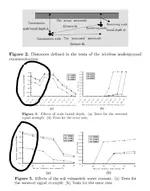vferrari, even though he asked me, I am more than happy to let you give Iron Buzz a detailed technical answer as to WHY 4 kHz works better in weakly mineralized soils

OK. I am inclined to give the "I Don't Know" answer, followed closely by "Because Andy Sabisch said so" but will try to actually answer the question with psuedo-science. First lets separate the issues. Frequency vs. Depth and Frequency vs. Mineralization. Also, remember that metal detectors are radiating radio signals (electromagnetic waves) that travel at around the speed of light regardless of frequency. Since the the speed/velocity of any waveform equals the product of the wavelength times the frequency, if the velocity is constant the wavelength has to go down proportionately as the frequency goes up. So if you know the frequency of an electromagnetic wave, you know the wavelength. The speed of light will change slightly in mediums other than a vacuum but it is insignificant for the materials we are talking about here (i.e., soil).
Frequency vs. Depth - lower frequency signals tend to penetrate further in material more dense than air, in general. That is because denser material is comprised of particles that tends to scatter high frequency RF signals (where the smaller wavelength of the higher frequency signals approaches the size of the scattering "particle") causing greater attenuation, and hence less penetration. This is also the property that makes high frequency signals more suitable to detecting small, less conductive targets because most of the waveform energy is absorbed by the smaller target if the wavelength is small which makes it more detectable. Longer wavelength (i.e., lower frequency) signals tend to lose less energy when bouncing of small conductive objects.
Frequency vs. Mineralization: Think of highly mineralized soil as consisting of more ferro-magnetic particles that would tend to scatter the small RF signals even more than non-mineralized soil similar to increasing density. Therefore, the lower frequency signal would penetrate better under these soil conditions since the mineralization would tend to exacerbate the signal attenuation of the higher frequncy signal.
These are generalizations and are subject to other effects, but I think it illustrates the point.
Bottom line you can make the following generalizations but as with all metal detecting advice - your mileage may vary because there are just too many variables to account for :
Generally use lower frequencies for max depth.
Generally use lower frequencies for high conductive targets.
Generally use low frequencies in highly mineralized soils.
Generally stay away from the highest frequency in trashy conditions.
Generally use high frequencies for low-conductive, small object detection.
Like I said, 8 and 12 khz are great starting, middle of the road frequencies that will cover most situations. Switch to the extreme frequencies for the above situations if 8 and 12 are not cutting the mustard for you or you have highe EMI at those frequencies.
Hope this helps.




 Ouch!
Ouch!
